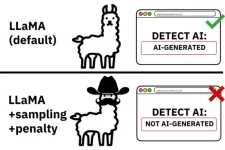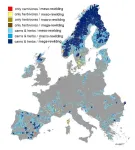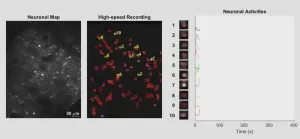(Press-News.org) Machine-generated text has been fooling humans for the last four years. Since the release of GPT-2 in 2019, large language model (LLM) tools have gotten progressively better at crafting stories, news articles, student essays and more, to the point that humans are often unable to recognize when they are reading text produced by an algorithm. While these LLMs are being used to save time and even boost creativity in ideating and writing, their power can lead to misuse and harmful outcomes, which are already showing up across spaces we consume information. The inability to detect machine-generated text only enhances the potential for harm.
One way both academics and companies are trying to improve this detection is by employing machines themselves. Machine learning models can identify subtle patterns of word choice and grammatical constructions to recognize LLM-generated text in a way that our human intuition cannot.
Today, many commercial detectors are claiming to be highly successful at detecting machine-generated text, with up to 99% accuracy, but are these claims too good to be true? Chris Callison-Burch, Professor in Computer and Information Science, and Liam Dugan, a doctoral student in Callison-Burch’s group, aimed to find out in their recent paper published at the 62nd Annual Meeting of the Association for Computational Linguistics.
Liam Dugan presents RAID at the 62nd Annual Meeting of the Association for Computational Linguistics in Bangkok.
“As the technology to detect machine-generated text advances, so does the technology used to evade detectors,” says Callison-Burch. “It’s an arms race, and while the goal to develop robust detectors is one we should strive to achieve, there are many limitations and vulnerabilities in detectors that are available now.”
To investigate those limitations and provide a path forward for developing robust detectors, the research team created Robust AI Detector (RAID), a data set of over 10 million documents across recipes, news articles, blog posts and more, including both AI-generated text and human-generated text. RAID serves as the first standardized benchmark to test detection ability in current and future detectors. In addition to creating the data set, they created a leaderboard, which publicly ranks the performance of all detectors that have been evaluated using RAID in an unbiased way.
“The concept of a leaderboard has been key to success in many aspects of machine learning like computer vision,” says Dugan. “The RAID benchmark is the first leaderboard for robust detection of AI-generated text. We hope that our leaderboard will encourage transparency and high-quality research in this quickly evolving field.”
Dugan has already seen the influence this paper is having in companies that develop detectors.
“Soon after our paper became available as a preprint and after we released the RAID data set, we started seeing the data set being downloaded many times, and we were contacted by Originality.ai, a prominent company that develops detectors for AI-generated text,” he says. “They shared our work in a blog post, ranked their detector in our leaderboard and are using RAID to identify previously hidden vulnerabilities and improve their detection tool. It’s inspiring to see that the community appreciates this work and also strives to raise the bar for AI-detection technology.”
So, do the current detectors hold up to the work at hand? RAID shows that not many do as well as they claim.
“Detectors trained on ChatGPT were mostly useless in detecting machine-generated text outputs from other LLMs such as Llama and vice versa,” says Callison-Burch. “Detectors trained on news stories don’t hold up when reviewing machine-generated recipes or creative writing. What we found is that there are a myriad of detectors that only work well when applied to very specific use cases and when reviewing text similar to the text they were trained on.”
Detectors are able to detect AI-generated text when it contains no edits or “disguises,” but when manipulated, current detectors are not reliably able to detect AI-generated text.
Faulty detectors are not only an issue because they don’t work well, they can be as dangerous as the AI tool used to produce the text in the first place.
“If universities or schools were relying on a narrowly trained detector to catch students’ use of ChatGPT to write assignments, they could be falsely accusing students of cheating when they are not,” says Callison-Burch. “They could also miss students who were cheating by using other LLMs to generate their homework.”
It’s not just a detector’s training, or lack thereof, that limits its ability to detect machine-generated text. The team looked into how adversarial attacks such as replacing letters with look-alike symbols can easily derail a detector and allow machine-generated text to fly under the radar.
“It turns out, there are a variety of edits a user can make to evade detection by the detectors we evaluated in this study,” says Dugan. “Something as simple as inserting extra spaces, swapping letters for symbols, or using alternative spelling or synonyms for a few words can cause a detector to be rendered useless.”
Swapping certain letters with similarly looking symbols is one type of adversarial attack that derails current detectors.
The study concludes that, while current detectors are not robust enough to be of significant use in society just yet, openly evaluating detectors on large, diverse, shared resources is critical to accelerating progress and trust in detection, and that transparency will lead to the development of detectors that do hold up in a variety of use cases.
“Evaluating robustness is particularly important for detection, and it only increases in importance as the scale of public deployment grows,” says Dugan. “We also need to remember that detection is just one tool for a larger, even more valuable motivation: preventing harm by the mass distribution of AI-generated text.”
“My work is focused on reducing the harms that LLMs can inadvertently cause, and, at the very least, making people aware of the harms so that they can be better informed when interacting with information,” he continues. “In the realm of information distribution and consumption, it will become increasingly important to understand where and how text is generated, and this paper is just one way I am working towards bridging those gaps in both the scientific and public communities.”
Dugan and Callison-Burch worked with several other researchers on this study, including Penn graduate students Alyssa Hwang, Josh Magnus Ludan, Andrew Zhu and Hainiu Xu, as well as a former Penn doctoral student Daphne Ippolito and Filip Trhlik, an undergraduate at University College London. They continue to work on projects that focus on advancing the reliability and safety of AI tools and how society integrates them into daily life.
This study was funded by the Intelligence Advanced Research Activity (IARPA), a directive of the Office of the Director of National Intelligence and within the Human Interpretable Attribution of Text Using Underlying Structure (HIATUS) program.
END
Detecting machine-generated text: An arms race with the advancements of large language models
Penn engineers develop new tool to detect AI-generated text
2024-08-15
ELSE PRESS RELEASES FROM THIS DATE:
Nearly 25% of European landscape could be rewilded
2024-08-15
Europe's abandoned farmlands could find new life through rewilding, a movement to restore ravaged landscapes to their wilderness before human intervention. A quarter of the European continent, 117 million hectares, is primed with rewilding opportunities, researchers report August 15 in the Cell Press journal Current Biology. They provide a roadmap for countries to meet the 2030 European Biodiversity Strategy's goals to protect 30% of land, with 10% of those areas strictly under conservation.
The team ...
Emergency departments could help reduce youth suicide risk
2024-08-15
A study of over 15,000 youth with self-inflicted injury treated in Emergency Departments (EDs) found that around 25 percent were seen in the ED within 90 days before or 90 days after injury, pointing to an opportunity for ED-based interventions, such as suicide risk screening, safety planning, and linkage to services. Nearly half of ED visits after the self-inflicted injury encounter were for mental health issues.
“Self-inflicted injury is an important predictor of suicide risk,” said Samaa Kemal, MD, MPH, emergency medicine physician at Ann & Robert H. Lurie ...
Uterus transplant in women with absolute uterine-factor infertility
2024-08-15
About The Study: Uterus transplant was technically feasible and was associated with a high live birth rate following successful graft survival. Adverse events were common, with medical and surgical risks affecting recipients as well as donors. Congenital abnormalities and developmental delays have not occurred to date in the live-born children.
Corresponding Author: To contact the corresponding author, Liza Johannesson, MD, PhD, email Liza.Johannesson@bswhealth.org.
To access the embargoed study: Visit our For The Media website at this link https://media.jamanetwork.com/
(doi:10.1001/jama.2024.11679)
Editor’s ...
Adverse childhood experiences and adult household firearm ownership
2024-08-15
About The Study: Consistent with prior research on adverse childhood experience (ACE; defined as abuse, neglect, and household dysfunction before age 18) exposure and presence of a firearm in the household during childhood, this study found that cumulative ACE exposure was associated with higher odds of household firearm ownership in adulthood. The relationship may be due to a heightened sense of vulnerability to physical violence and greater perceived threats to personal safety associated with a traumatic childhood, which lead individuals to seek self-protection.
Corresponding Author: To contact the corresponding author, Alexander Testa, PhD, email alexander.testa@uth.tmc.edu.
To ...
Warning signs: National data indicate that autistic birthing people are at increased risk for postpartum anxiety and depression
2024-08-15
American women have the highest rate of maternal deaths among high-income countries, with outcomes worse for minoritized groups. In an effort to understand the maternal health of pregnant people with intellectual and developmental disabilities, including autism and intellectual disability, researchers from Drexel University’s Policy and Analytics Center in the A.J. Drexel Autism Institute examined Medicaid data to identify perinatal and postpartum outcomes among people with intellectual and developmental disabilities. The study was recently published in JAMA Network Open.
“While ...
Can a mouthwash-based test help predict head and neck cancer recurrence?
2024-08-15
MIAMI, FLORIDA (EMBARGOED UNTIL AUG. 15, 2024 @ 11 A.M. EDT) – For years, mouthwash has been marketed as an essential hygiene item to prevent bad breath, even though it offers minimal if any health benefits.
But what if a mouthwash-based test to detect biomarkers can help physicians predict disease recurrence in head and neck cancer patients?
That futuristic scenario seems closer to reality after a new study by researchers at Sylvester Comprehensive Cancer Center at the University of Miami Miller School of Medicine, UC San Diego Health and collaborating cancer centers.
Their findings, ...
University of Michigan School of Public Health department renamed Health Behavior & Health Equity, reflecting longstanding commitment to health equity
2024-08-15
The Department of Health Behavior & Health Education at the University of Michigan School of Public Health will become the Department of Health Behavior & Health Equity, effective August 15, 2024. The new name reflects the department’s increasing focus on issues of health equity in research, teaching and service.
“Health equity is at the core of our mission and actions in public health,” said F. DuBois Bowman, dean of Michigan Public Health. “I am grateful to the many members of the Health Behavior & Health Equity community ...
New microscope offers faster, high-resolution brain imaging
2024-08-15
WASHINGTON — Researchers have developed a new two-photon fluorescence microscope that captures high-speed images of neural activity at cellular resolution. By imaging much faster and with less harm to brain tissue than traditional two-photon microscopy, the new approach could provide a clearer view of how neurons communicate in real time, leading to new insights into brain function and neurological diseases.
“Our new microscope is ideally suited for studying the dynamics of neural networks in real time, which is crucial for understanding fundamental brain functions such as learning, memory and decision-making,” said research team leader ...
Over half of iron deficiency cases in large health system still unresolved at three years
2024-08-15
(WASHINGTON, August 15, 2024) – Over half of people with iron deficiency were found to still have low iron levels three years after diagnosis, and among patients whose condition was effectively treated within that timeframe, they faced longer-than-expected delays, pointing to substantial gaps in appropriate recognition and efficient treatment of the condition, according to a study published today in Blood Advances.
Iron deficiency, or when the body’s iron stores are too low, is common, and may affect up to 40% of adolescents and young women. Iron is important in maintaining many body functions, including the production of ...
NIH launches program to advance research led by Native American communities on substance use and pain
2024-08-15
The National Institutes of Health (NIH) has launched a program that will support Native American communities to lead public health research to address overdose, substance use, and pain, including related factors such as mental health and wellness. Despite the inherent strengths in Tribal communities, and driven in part by social determinants of health, Native American communities face unique health disparities related to the opioid crisis. For instance, in recent years, overdose death rates have been highest among American Indian and Alaska Native people. Research prioritized by Native communities is essential ...
LAST 30 PRESS RELEASES:
American College of Cardiology comments on new dietary guidelines for Americans
American Society of Gene & Cell Therapy and Orphan Therapeutics Accelerator partner to advance and commercialize promising rare disease treatments
One in 14 patients having day case surgery have new or worse chronic pain 3 months after their operation
New study highlights link between eviction rates and gun violence
Heatwaves heat up soil but not toxin levels in rice, study finds
Digital modeling reveals where construction carbon emissions really come from
Turning farm waste into water filters
New study shows how the spleen helps the immune system accept a transplant
New Mayo Clinic study advances personalized prostate cancer education with an EHR-integrated AI agent
Researchers identify novel therapeutic target to improve recovery after nerve injury
Microbes in breast milk help populate infant gut microbiomes
Reprogramming immunity to rewrite the story of Type 1 diabetes
New tool narrows the search for ideal material structures
Artificial saliva containing sugarcane protein helps protect the teeth of patients with head and neck cancer
Understanding the role of linear ubiquitination in T-tubule biogenesis
Researchers identify urban atmosphere as primary reservoir of microplastics
World’s oldest arrow poison – 60,000-year-old traces reveal early advanced hunting techniques
Bristol scientists discover early sponges were soft
New study uncovers how rice viruses manipulate plant defenses to protect insect vectors
NSF–DOE Vera C. Rubin Observatory spots record-breaking asteroid in pre-survey observations
Ribosomal engineering creates “super-probiotic” bacteria
This self-powered eye tracker harnesses energy from blinking and is as comfortable as everyday glasses
Adverse prenatal exposures linked to higher rates of mental health issues, brain changes in adolescents
Restoring mitochondria shows promise for treating chronic nerve pain
Nature study identifies a molecular switch that controls transitions between single-celled and multicellular forms
USU chemists' CRISPR discovery could lead to single diagnostic test for COVID, flu, RSV
Early hominins from Morocco reveal an African lineage near the root of Homo sapiens
Small chimps, big risks: What chimps show us about our own behavior
We finally know how the most common types of planets are created
Thirty-year risk of cardiovascular disease among healthy women according to clinical thresholds of lipoprotein(a)
[Press-News.org] Detecting machine-generated text: An arms race with the advancements of large language modelsPenn engineers develop new tool to detect AI-generated text



